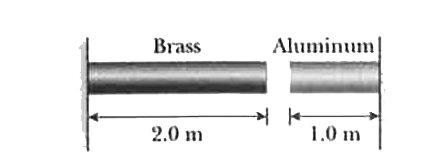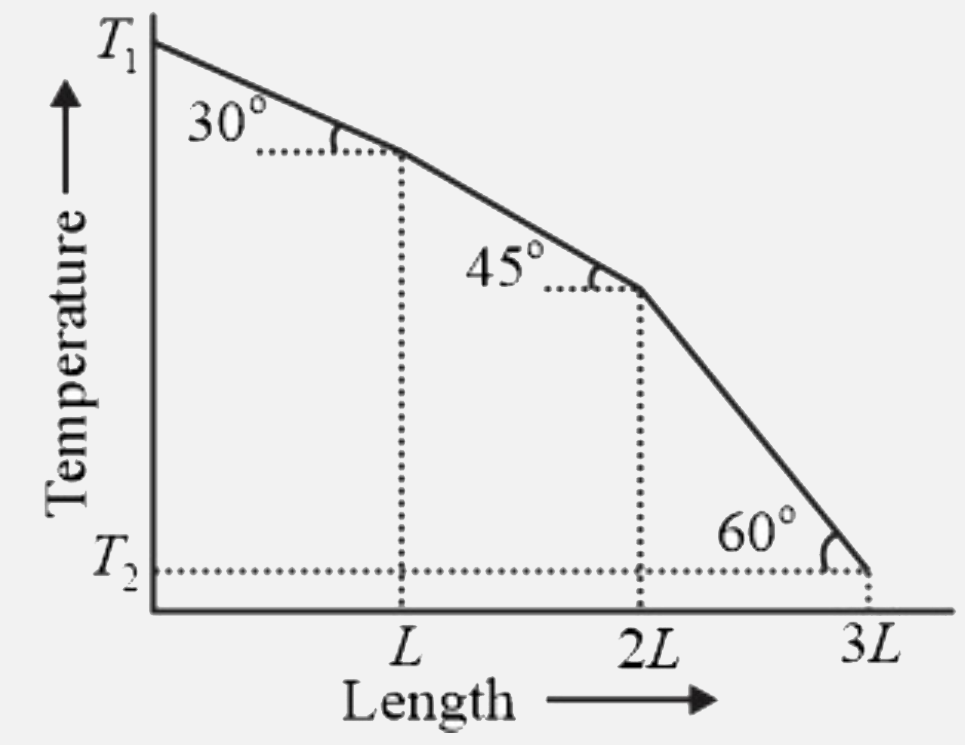The figure shows two thin rods , one made of aluminium [α=23×10−6(C∘)−1] and the other of steel [α=12×10−6(C∘)−1]. Each rod has the same length and the same initial temperature . They are attached at one end to two separate immovable walls. Temperature of both the rods is increased by the same amount , until the gap between the rods vanishes . Where do the rods meet the gap vanishes?
![The figure shows two thin rods , one made of aluminium [alpha = 23 xx 10^(-6) (C^(@))^(-1)] and the other of steel [alpha = 12 xx 10^(-6) (C^(@))^(-1)]. Each rod has the same length and the same initial temperature . They are attached at one end to two separate immovable walls. Temperature of both the rods is increased by the same amount , until the gap between the rods vanishes . Where do the rods meet the gap vanishes?](https://d10lpgp6xz60nq.cloudfront.net/physics_images/ALN_PHY_C07(I)_S01_077_Q01.png)
The rods meet exactly at the midpoint.
The rods meet to the right of the midpoint.
The rods meet to the left of the midpoint .
Information insufficient
The correct Answer is:B
As αAt>αsteel so expansion in aluminum rod is greater .
Topper's Solved these Questions
- BOOK - ALLENCHAPTER - GEOMETRICAL OPTICSEXERCISE - EXERCISE -0165videos
GEOMETRICAL OPTICS
- BOOK - ALLENCHAPTER - GEOMETRICAL OPTICSEXERCISE - EXERCISE -0282videos
GEOMETRICAL OPTICS
- BOOK - ALLENCHAPTER - GEOMETRICAL OPTICSEXERCISE - subjective14videos
GEOMETRICAL OPTICS
- BOOK - ALLENCHAPTER - CURRENT ELECTRICITYEXERCISE - All Questions427videos
CURRENT ELECTRICITY
- BOOK - ALLENCHAPTER - GRAVITATIONEXERCISE - EXERCISE 49videos
GRAVITATION
Similar Questions
A composite rod made of copper (α=1.8×10−5K−1) and steel (alpha = 12xx10^-5 K^-1) is heated. Then
View SolutionA brass rod of length 1m is fixed to a vertical wall at one end, with the other end keeping free to expand. When the temperature of the rod is increased by 120∘C, the length increases by 3cm. What is the strain?
View Solution
Knowledge Check
- Question 1 - Select One or More
Four rods A,B,C and 1) of the same length and material but of different radii r,r√2,r√3 and 2r, respectively, are held between two rigid walls. The temperature of all rods is increased through the same range. If the rods do not bend, then
Athe stress in the rods A,B,C and D is in the ratio 1:2:3:4Bthe forces on them exerted by the wall are in the ratio 1:2:3:4Cthe energy stored in the rods due to elasticity is in the ratio 1:2:3:4Dit is independent of area like surface tension while friction depends - Question 2 - Select One
The ends of a cylinder steel rod are maintained at two different temperatures. The rod conducts heat from one end to the other at a rate of 10 cal/ s. At what rate would a steel rod twice as long and twice the diameter conduct heat between the same two temperatures?
A5 cal /sB10 cal / sC20 cal / sD40 cal / s - Question 3 - Select One
Two rods of the same length and areas of cross-section A1 and A2 have their ends at the same temperature. K1 and K2 are the thermal conductivities of the two rods. The rate of flow of heat is same in both the rods if-
AA1A2=L1K2BA1A2=K2K1CA1A2=K1K2Dplaced in hot oil
The brass bar and the alumiumn bar in the drawing are each attached to an immovable wall. At 28∘C the air gap between the rods is 1.3×10−3 m . At what temperature will the be closed ?
 View Solution
View SolutionThree rods of the same length and the same area of the cross-section are joined. The temperature of two ends one T1 and T2 as shown in the figure.
 As we move along the rod the variation of temperature are as shown in the following [Rods are insulated from the surrounding except at the faces]
As we move along the rod the variation of temperature are as shown in the following [Rods are insulated from the surrounding except at the faces]
 View Solution
View SolutionTwo rods, one of iron and the other of aluminium, are heated to the same temperature. Then,
View SolutionTwo cylindrical rods of same meterial have the same temperature difference between their ends. The ratio of rates of flow of heat through them is 1 : 8. The ratio of the radii of the rods are 1 : 2. What is the ratio of their lengths ?
View SolutionTwo rods, one of aluminium and the other made of steel, having initial length l1andl2 are connected together to from a single rod of length l1+l2. The coefficients of linear expansion for aluminium and steel are αaandαs and respectively. If the length of each rod increases by the same amount when their temperature are raised by t0C, then find the ratio l1/(l1+l2)
View Solution

